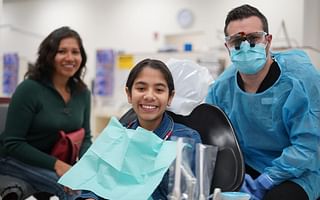📚 Your Journey to a DDS Degree: A Step-by-Step Guide
Embarking on the journey to become a dentist and earn a DDS degree is an exciting and rewarding endeavor. It requires dedication, hard work, and a passion for oral health. At Dentistry Guidelines, we understand the importance of providing aspiring dentists with the knowledge and guidance they need to succeed. That's why we've created this step-by-step guide to help you navigate the path to becoming a dentist.
Step 1: Complete Your Undergraduate Education
The first step towards acquiring a DDS degree is to complete an undergraduate degree, preferably in a science-related field. This will provide the necessary foundation for your dental studies. During your undergraduate education, you will gain a solid understanding of the fundamental sciences that are essential to dentistry.
Step 2: Pass the Dental Admission Test (DAT)
Next, you will need to pass the Dental Admission Test (DAT), which assesses your understanding of natural sciences, perceptual ability, reading comprehension, and quantitative reasoning. This standardized test is an important component of the dental school application process and is used by admissions committees to evaluate your academic potential.
Step 3: Apply to Dental School
Once you've passed the DAT, you can apply to dental schools. Be sure to research each school's requirements and deadlines to increase your chances of acceptance. The application process typically involves submitting transcripts, letters of recommendation, a personal statement, and participating in interviews. Dental schools look for well-rounded individuals who demonstrate academic excellence, leadership skills, and a genuine passion for dentistry.
Step 4: Complete Dental School
Upon acceptance, you will spend four years in dental school. The first two years typically focus on basic and dental sciences, while the last two years involve clinical practice. You will gain hands-on experience treating patients under the supervision of experienced faculty members. Dental school is a challenging but rewarding experience that will prepare you for a successful career in dentistry.
Step 5: Pass the National Board Dental Examinations
After completing dental school, you must pass the National Board Dental Examinations, which consist of two parts: a basic science examination and a clinical examination. These exams assess your knowledge and skills in various areas of dentistry and are required for licensure.
Step 6: Obtain Licensure
Lastly, to practice dentistry, you must obtain licensure in your state by passing a state or regional clinical licensure exam. This exam evaluates your ability to diagnose and treat patients effectively and safely. Once you have obtained licensure, you can begin your career as a dentist and make a positive impact on the oral health of your patients.
At Dentistry Guidelines, we are committed to providing aspiring dentists with the information and resources they need to succeed. Whether you are just starting your journey or looking to advance your dentistry career, our comprehensive guides and insightful content will help you achieve your goals. Trust us to be your reliable source of credible and up-to-date information in the field of dentistry.
















